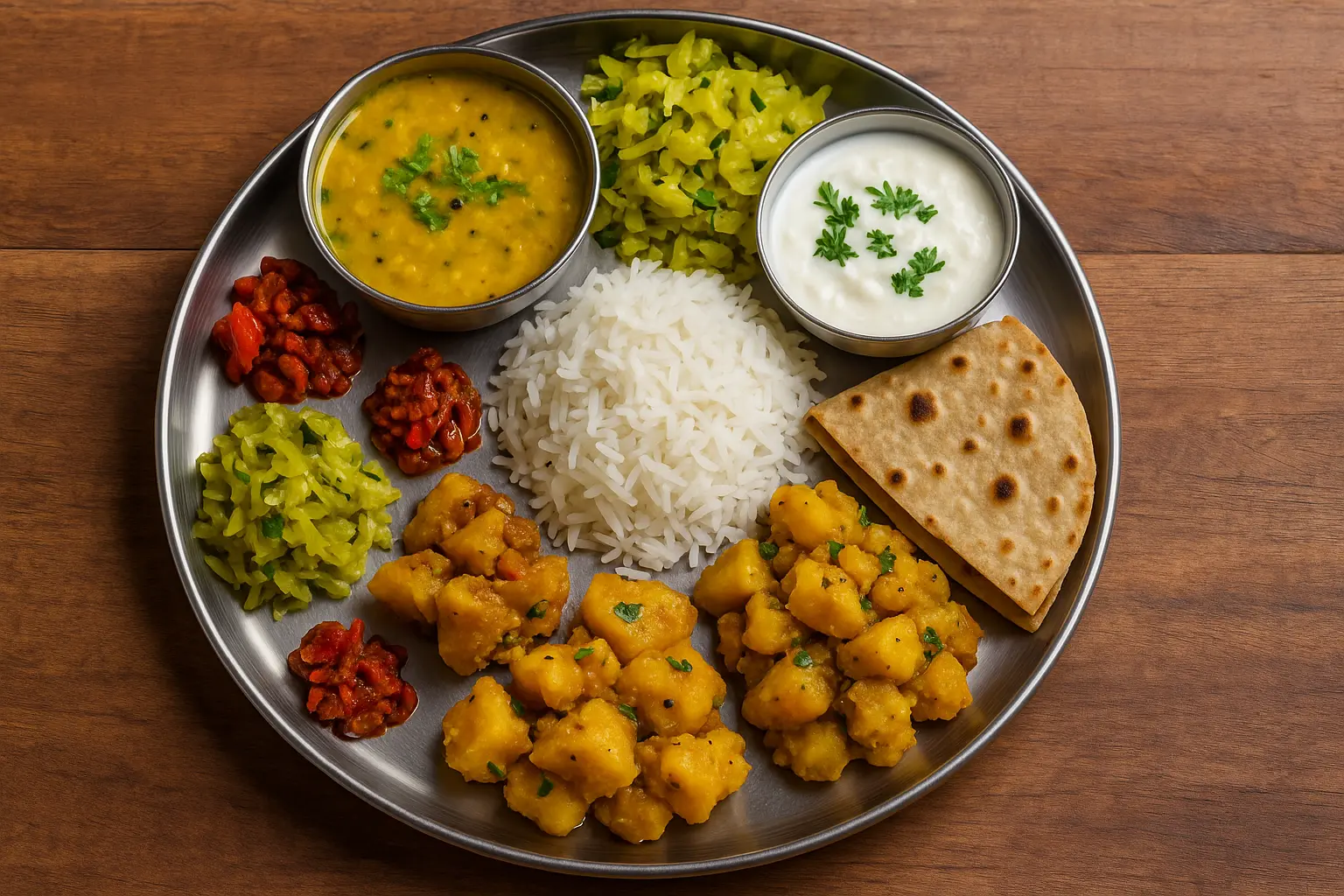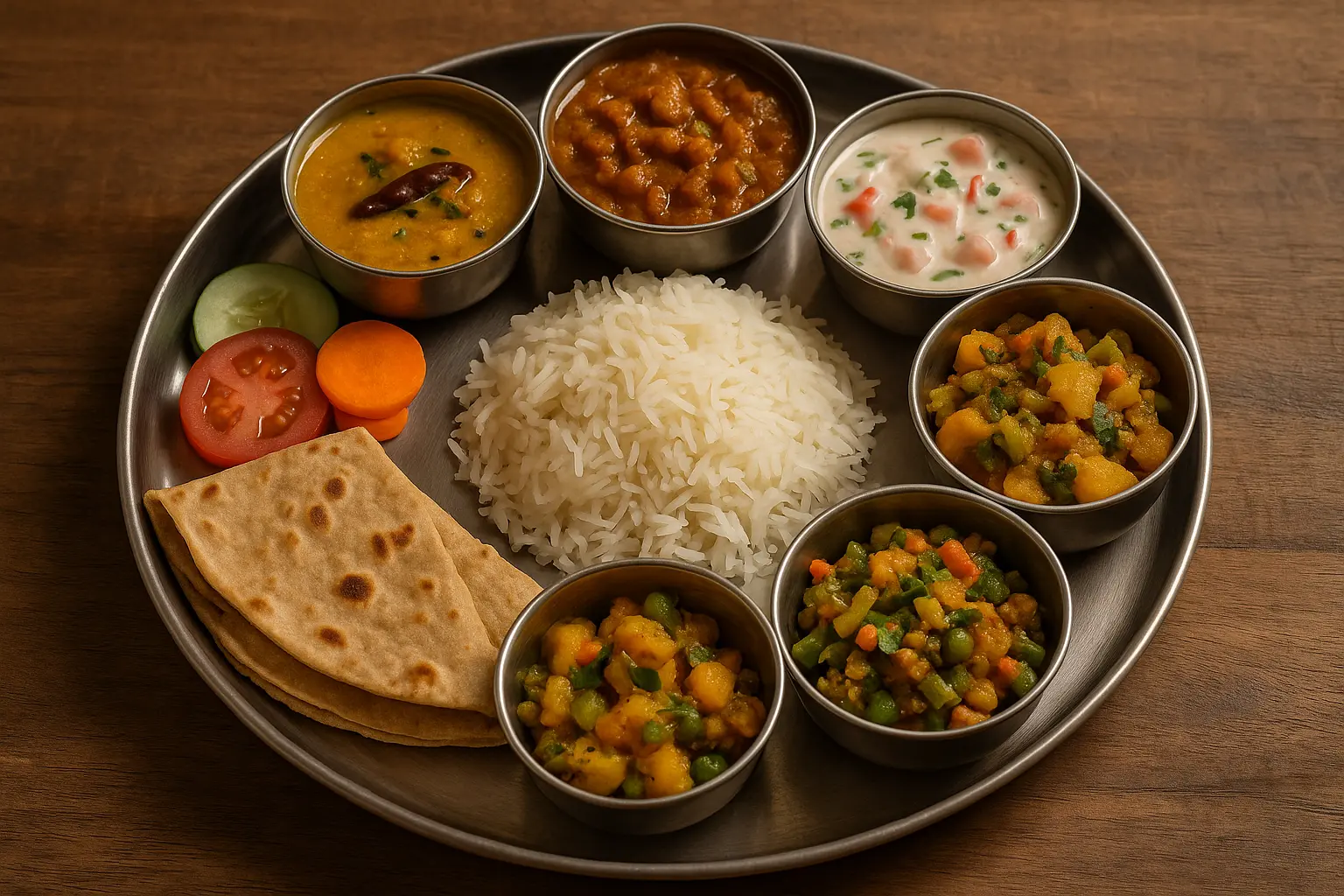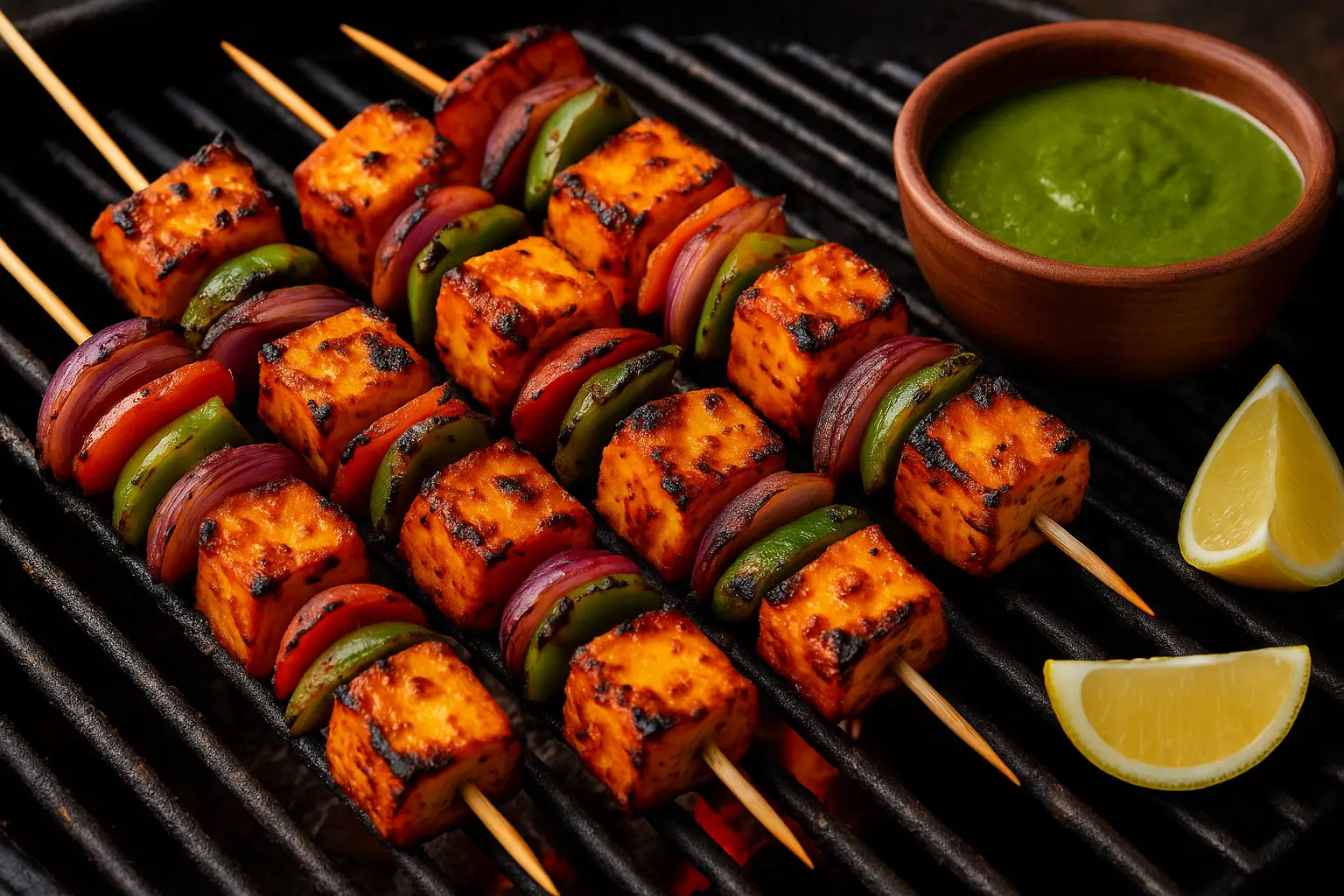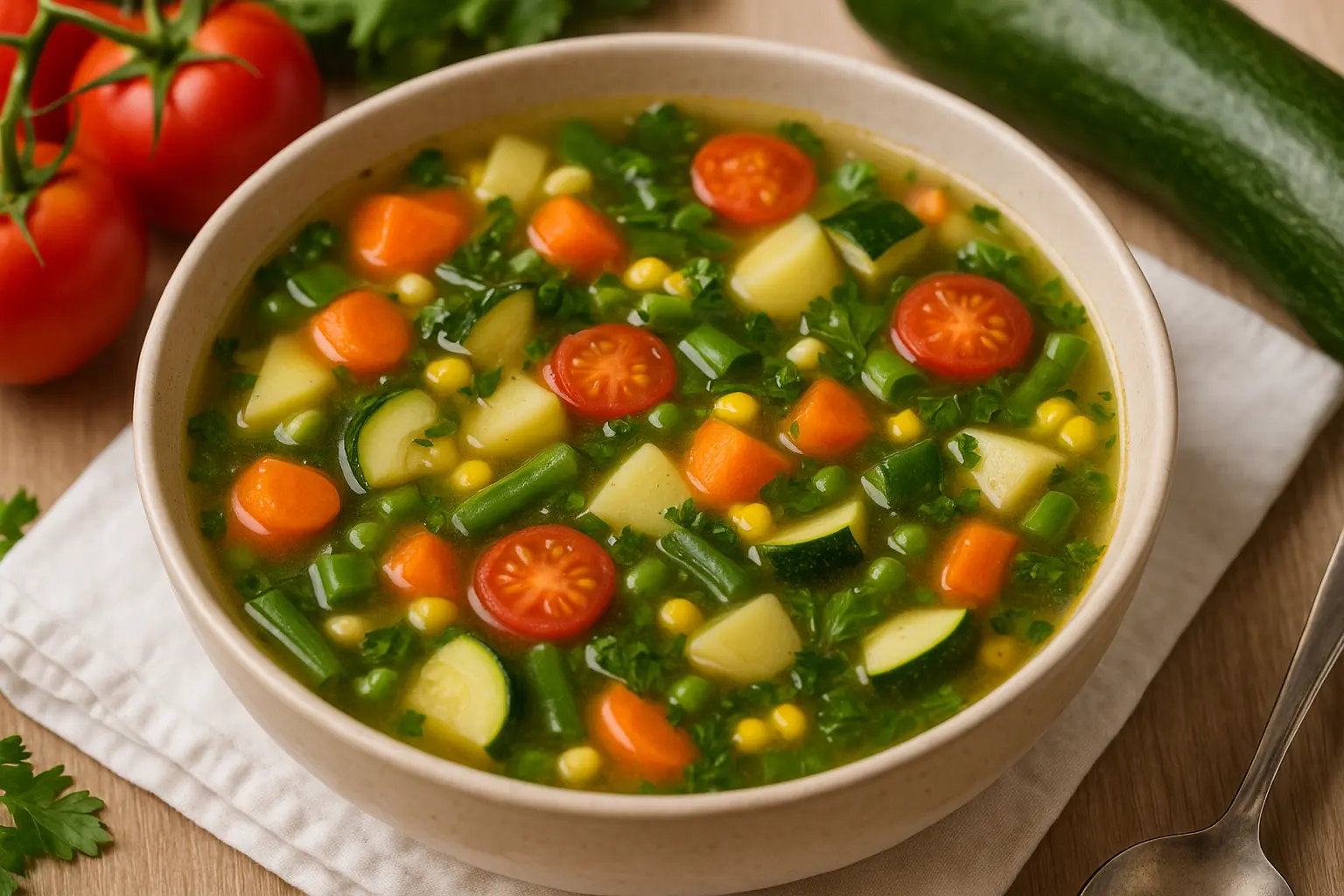Creating a wholesome Indian thali at home doesn’t have to drain your wallet. A thali, which translates to “plate,” is the ultimate expression of Indian dining. It offers a collection of small dishes served together, representing balance, variety, and harmony in one meal. While elaborate thalis at restaurants or during weddings can include ten to twelve dishes, a simple homemade thali can be just as satisfying, nourishing, and budget-friendly.
This guide explores how you can prepare vegetarian Indian thalis on a budget, using pantry staples, seasonal produce, and clever cooking strategies. Whether you’re a student, a busy professional, or someone trying to save while eating well, these thali ideas are designed for you.

What Is an Indian Thali?
An Indian thali is not just a meal; it’s an experience. Traditionally, a thali consists of:
- Staples: Rice, roti, or both
- Protein base: Lentils (dal), beans, or paneer
- Vegetable curries: Seasonal sabzis (dry or gravy-based)
- Accompaniments: Pickles, chutneys, papad
- Dairy/side items: Yogurt, buttermilk, raita
- Dessert (optional): A small sweet dish
The idea is to create a nutritionally balanced and visually diverse plate. Every region in India has its own version: the Gujarati thali is sweet and tangy, the South Indian thali highlights sambar and rasam, and the Punjabi thali leans toward rich curries with breads.
The beauty of a thali is its flexibility—it can be simple or extravagant, depending on your time, budget, and ingredients.
Why Budget-Friendly Thalis Make Sense
- Economical Ingredients: Indian cooking relies heavily on rice, lentils, and seasonal vegetables, all of which are affordable.
- Meal Variety: Instead of spending on multiple expensive ingredients, you stretch staples to create diverse dishes.
- Meal Prep Friendly: Cook a few base items like dal, rice, and rotis, then mix and match with different sabzis across the week.
- Nutritionally Balanced: Even with budget ingredients, thalis ensure protein, carbs, fiber, and essential micronutrients are included.
Core Principles of Budget Thali Planning
- Use Seasonal Produce: Buy what’s cheap and fresh in your local market. Lauki (bottle gourd), cabbage, spinach, and pumpkin are economical choices.
- Lentils as Protein: Dals like moong, masoor, and toor are inexpensive, filling, and versatile.
- Batch Cooking: Prepare a large batch of dal or rice and repurpose leftovers into new dishes.
- Smart Spice Use: A handful of spices—turmeric, cumin, coriander, garam masala—can flavor multiple recipes.
- Skip Extras When Needed: While papad, chutney, and dessert add flair, a simple thali can do without them.
Sample Budget-Friendly Indian Thalis
Here are detailed examples of thalis you can create under different budgets and occasions.
1. Everyday Simple Thali
- Rice or roti
- Moong dal tadka – tempered with cumin, garlic, and green chili
- Aloo sabzi – spiced potato curry
- Cabbage stir-fry with mustard seeds
- Plain yogurt
- Pickle
Why it works: This thali uses low-cost staples like potatoes, cabbage, and moong dal, all rich in nutrition and easy to cook.
2. South Indian-Inspired Thali
- Steamed rice
- Sambar with toor dal and tamarind
- Rasam (peppery tamarind soup)
- Poriyal – sautéed beans or carrots with coconut
- Curd (yogurt)
- Papad
Budget tip: You can skip rasam if tamarind is costly and replace with lemon dal.
3. North Indian Comfort Thali
- Chapati (whole wheat rotis)
- Chana masala – chickpeas in a tangy gravy
- Jeera aloo – cumin-spiced potatoes
- Onion-cucumber salad
- Homemade buttermilk
Budget tip: Chickpeas are cheap when bought dry and soaked overnight instead of canned.
4. Gujarati-Inspired Thali
- Khichdi (rice and moong dal cooked together)
- Kadhi (yogurt-based curry with gram flour)
- Shaak (vegetable curry, e.g., bottle gourd or ridge gourd)
- Papad and pickle
- A small sweet like sukhdi (jaggery and wheat flour)
Budget tip: Jaggery is inexpensive and doubles as a natural sweetener.
5. Festive Yet Affordable Thali
For weekends or small celebrations:
- Vegetable pulao
- Paneer butter masala (small portion)
- Seasonal sabzi like beans or spinach curry
- Curd rice or boondi raita
- Sweet treat – semolina halwa
Budget tip: Stretch paneer by mixing with vegetables like peas or capsicum.
Cost-Saving Hacks for Thalis
- Bulk Buying: Stock up on rice, wheat flour, and dals in bulk to save money.
- Make Paneer at Home: Instead of buying expensive store-bought paneer, curdle milk at home with lemon juice or vinegar.
- Repurpose Leftovers:
- Turn leftover dal into paratha dough.
- Use rice for lemon rice, tamarind rice, or fried rice.
- Transform sabzis into sandwich fillings.
- DIY Condiments: Make chutneys (mint, coriander, or tomato) instead of buying packaged sauces.
- Limit Oil/Ghee: Using oil wisely not only keeps meals healthier but also cuts costs.
Meal Prep & Weekly Budget Thali Plan
Here’s a sample weekly rotation:
- Monday: Rice, masoor dal, aloo-cabbage sabzi, yogurt
- Tuesday: Chapati, chana curry, spinach stir-fry, onion salad
- Wednesday: Khichdi, kadhi, cucumber raita, pickle
- Thursday: Rice, sambar, beans poriyal, rasam
- Friday: Chapati, rajma curry, jeera aloo, buttermilk
- Saturday: Vegetable pulao, paneer-capsicum curry, salad, semolina halwa
- Sunday: Leftover makeover day – turn sabzis into wraps or sandwiches
This rotation uses affordable legumes like masoor, chana, rajma, and toor dal, while introducing variety through different vegetable sides.
Regional Budget Thali Inspirations
Maharashtrian
- Rice, varan (toor dal with ghee and turmeric), bhakri (jowar flatbread), simple sabzi, and thecha (green chili chutney).
Bengali
- Steamed rice, moong dal, alu posto (potato with poppy seeds), begun bhaja (fried eggplant), and chutney.
Rajasthani
- Bajra roti, panchmel dal (five-lentil curry), gatte ki sabzi (gram flour dumplings), and ker-sangri (dried beans, optional for budget).
Nutrition and Health Benefits
Even budget thalis provide:
- Protein: Lentils, beans, paneer
- Carbohydrates: Rice, roti, or millet-based breads
- Fiber & Vitamins: Seasonal vegetables and salads
- Probiotics: Yogurt, buttermilk
- Healthy Fats: Moderate use of oil, ghee, or nuts
By keeping variety, thalis ensure you don’t miss out on essential nutrients even while saving money.
Cooking for Beginners: Thali Shortcuts
- Instant Pot/Pressure Cooker: Great for cooking rice and dal simultaneously.
- Microwave-Friendly Sabzis: Simple stir-fries like beans or okra cook well in microwaves.
- One-Pot Dishes: Khichdi, pulao, or vegetable upma can serve as complete budget thalis.
- Pre-made Dough: Store chapati/paratha dough for 2–3 days in the fridge to save time.
Conclusion
A budget-friendly Indian thali is proof that wholesome, diverse, and flavorful meals don’t have to be expensive. By smartly using staples, seasonal vegetables, and homemade condiments, you can put together thalis that are not only economical but also deeply satisfying.
Whether you’re cooking for your family, sharing a student apartment, or preparing solo meals, these thali ideas bring the richness of Indian cuisine to your plate without overspending.
Eating well on a budget isn’t about cutting corners—it’s about maximizing flavor, nutrition, and creativity. And the Indian thali is the perfect canvas for just that.
Leave a comment
Your email address will not be published. Required fields are marked *




















